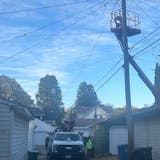ELBA, MINN. — In an encampment of several hundred Hmong hunters nestled amid the valleys and bluffs of southeastern Minnesota, Kong Lor helped his dad and uncle unload firewood from their pickup Friday in preparation for Saturday's Minnesota firearms deer season opener.
For generations, white hunters have gathered at deer shacks and camps around Minnesota. Now Hmong hunters have embraced that tradition -- and made it their own.
"Hopefully, we'll get at least one deer," said Lor, 21, of St. Paul. "But we come mostly for the fun -- and to get away from work."
Said his uncle, Nhia Her, 38, with a grin: "I want a buck, but I'll take what I can get."
They were among the mostly Hmong hunters from the Twin Cities who jammed the small Trout Valley Trail campground Friday near the sprawling Whitewater Wildlife Management Area.
Hundreds, maybe thousands, of Hmong hunters will be in the southeastern bluff lands early Saturday, among nearly 500,000 orange-clad hunters who will fan out statewide for the opener.
Of 50,000 Hmong Minnesotans, an estimated 10,000 now buy state hunting licenses, easily making them the largest minority group in the state to do so.
And in the years during which the Hmong have made the state their home, the Whitewater Wildlife Area -- 28,000 acres of pristine woods, valleys, ravines and streams -- has become ground zero for legions of Hmong hunters. Another 45,000 acres of state forest is nearby. That's more than 100 square miles -- a gold mine of public hunting land to roam. The area traditionally holds many deer, including some big ones, in a landscape reminiscent of the Southeast Asia.


